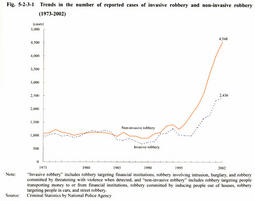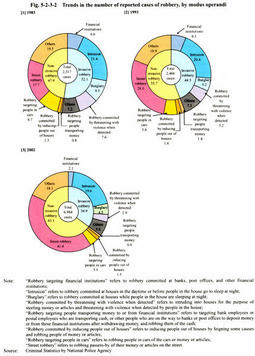| Previous Next Index Image Index Year Selection | |
|
|
1 Trends in Robbery from the perspective of the scene and modus operandi of the offense Fig. 5-2-3-1 and Fig. 5-2-3-2 show the trends in the scene and the modus operandi of the offense in respect of robbery, of which the number of reported cases has been increasing significantly in recent years. Comparing the trends between invasive robbery and non-invasive robbery, the number of reported cases turned upward after remaining flat or declining slightly for about 15 years until 1989 for both types of robbery. The number has been increasing significantly since 1996 for non-invasive robbery and since 1998 for invasive robbery, and it increased 3.7-fold from 1995 to 2002 for non-invasive robbery and 2.4-fold from 1997 to 2002 for invasive, robbery. As for the shares of non-invasive robbery and invasive robbery in the number of reported cases, they previously had been almost the same, but recently, the share of non-invasive robbery has been rising due to a significant increase in the number of reported cases of non-invasive robbery. According to the breakdown of robbery cases over the last 20 years focusing on 1983, 1993, and 2002, by type of offense, the share of non-invasive robbery has been rising from 47.9% to 55.7% and 65.1%, and in particular, the share of street robbery has been rising rapidly from 17.7% to 28.0% and 41.4%, indicating that the possibility of being robbed on the street has been gradually increasing.
Fig. 5-2-3-1 Trends in the number of reported cases of invasive robbery and non-invasive robbery (1973-2002) Fig. 5-2-3-2 Trends in the number of reported cases of robbery, by modus operandi |

